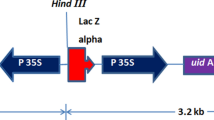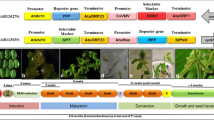Summary
Techniques for transforming intact tissues of cereals were evaluated for their efficacy in transforming immature embryos and Type II callus of maize (Zea mays L.). The techniques used were particle bombardment, tissue electroporation, tissue electrophoresis, and silicon carbide fibers. Each method was assessed in terms of transient β-glucuronidase (GUS) expression. High levels of GUS expression were observed in A188 Type II callus using both tissue electroporation and particle bombardment, with means of 417.8 and 954.5 blue expression units (beu) per g fresh weight (FW) callus, respectively. Only particle bombardment resulted in high transient gene expression in immature embryos, with a mean transformation frequency of 34.8 b.e.u. per embryo. Very low levels of GUS expression were achieved with silicon carbide-mediated gene transfer, even when employing tissues used in the original publication (Black Mexican Sweet suspension cells). GUS expression was not obtained following tissue electrophoretic gene delivery.
Similar content being viewed by others
References
Abdullah, A., Cocking, E. C.; Thomspon, J. A. Efficient plant regeneration from rice protoplasts through somatic embryogenesis. Bio/Technology 4:1087–1090; 1986.
Ahokas, H. Transfection of germinating barley seed electrophoretically with exogenous DNA. Theor. Appl. Genet. 77:469–472; 1989.
Akella, V.; Lurquin, P. F. Expression in cowpea seedlings of chimeric, transgenes after electroporation into seed-derived embryos. Plant Cell Rep. 12:110–117; 1993.
Alfinito, S. C. H.; Dietrich, P. S.; Murry, L. E., et al. Plant tissue transformation. European Patent Application No. 93810412.2; 1993.
Armstrong, C. L. Development and availability of germplasm with high Type II culture formation response. Maize Genet. Coop. Newl. 65:92–93; 1991.
Armstrong, C. L.; Parker, G. B.; Pershing, J. C., et al. Field evaluation of European corn borer control in progeny of 173 transgenic corn events expressing an insecticidal protein fromBacillus thuringiensis. Crop Sci. 35:550–557; 1995.
Chibbar, R. N.; Kartha, K. K.; Datla, R. S. S., et al. The effect of different promoter-sequences on transient expression of gus reporter gene in cultured barley (Hordeum vulgare L.) cells. Plant Cell Rep. 12:506–509; 1993.
Christensen, A. H.; Sharrock, R. A.; Quail, P. H. Maize polyubiquitin genes—structure, thermal perturbation of expression and transcript splicing, and promoter activity following transfer to protoplasts by electroporation. Plant Mol. Biol. 18:675–689; 1992.
Christou, P. Strategies for variety-independent genetic transformation of important cereals, legumes and woody species utilizing particle bombardment. Euphytica 85:13–27; 1995.
Chu, C. C.; Wang, C. C.; Sun, C. S., et al. Establishment of an efficient medium for anther culture of rice through comparative experiments on the nitrogen sources. Scientia Sinica 18:659–668; 1975.
Dekeyser, R. A.; Claes, B.; De Rycke, R. M. U., et al. Transient gene expression in intact and organized rice tissues. Plant Cell 2:591–602; 1990.
De la Pena, A.; Lörz, H.; Schell, J. Transgenic rye plants obtained by injecting young floral tillers. Nature 325:274–276; 1987.
Dennehey, B. K.; Peterson, W. L.; Ford-Santino, C., et al. Comparison of selective agents for use with the selectable marker genebar in maize transformation. Plant Cell Tissue Organ Cult. 36:1–7; 1994.
D'Halluin, K.; Bonne, E.; Bossut, M., et al. Transgenic maize plants by tissue electroporation. Plant Cell 4:1495–1505; 1992.
Dong, J.; Teng, W.; Buchholz, W., et al.Agrobacterium-mediated transformation of Javanica rice. Mol. Biol. 2:267–276; 1996.
Finer, J. J.; Vain, P.; Jones, M. W., et al. Development of the particle inflow gun for DNA delivery into plant cells. Plant Cell Rep. 11:323–328; 1992.
Frame, B. R.; Drayton, P. R.; Bagnall, S. V., et al. Production of fertile transgenic maize plants by silicon carbide whisker-mediated transformation. Plant J. 6:941–948; 1994.
Frearson, E. M.; Power, J. B.; Cocking, E. C. The isolation, culture and regeneration ofPetunia leaf protoplasts. Dev. Biol. 33:130–137; 1973.
Fromm, M. E.; Morrish, F.; Armstrong, C., et al. Inheritance and expression of chimeric genes in the progeny of transgenic maize plants. Bio/Technology 8:833–839; 1990.
Fromm, M.; Taylor, L. P.; Walbot, V. Stable transformation of maize after gene transfer by electroporation. Nature 319:791–793; 1986.
Gordon-Kamm, W. J.; Spencer, T. M.; Mangano, M. L., et al. Transformation of maize cells and regeneration of fertile transgenic plants. Plant Cell 2:603–618; 1990.
Griesbach, R. J. An improved method for transforming plants through electrophoresis. Plant Sci. 102:81–89; 1994.
Hiei, Y.; Ohta, S.; Komari, T., et al. Efficient transformation of rice (Oryza sativa L.) mediated byAgrobacterium and sequence analysis of the boundaries of the T-DNA. Plant J 6:271–282; 1994.
Hooykaas, P. J. J.; Schilperoort, R. A. The Ti-plasmid ofAgrobacterium tumefaciens: a natural genetic engineer. Trends Biochem. Sci. 10:307–309; 1985.
Ishida, Y.; Saito, H.; Ohta, S., et al. High efficiency transformation of maize (Zea mays. L.) mediated byAgrobacterium tumefaciens. Nature Biotechnol. 14:745–750; 1996.
Jefferson, R. A.; Kavanagh, T. A.; Bevan, M. W. GUS fusions: β-glucuronidase as a sensitive and versatile gene fusion marker in higher plants. EMBO J. 6:3901–3907; 1987.
Kaeppler, H. F.; Gu, W.; Somers, D. A., et al. Silicon carbide fiber-mediated DNA delivery into plant cells. Plant Cell Rep. 9:415–418; 1990.
Koziel, M. G.; Belandi, G. L.; Bowman, C., et al. Field performance of elite transgenic maize plants expressing an insecticidal protein derived fromBacillus thuringiensis. Bio/Technology 11:194–200; 1993.
Li, L.; Qu, R.; de Kochko, A., et al. An improved rice transformation system using the biolistic method. Plant Cell Rep. 12:250–255; 1993.
Lowe, K.; Bown, B.; Hoerster, G., et al. Germline transformation of maize following manipulation of chimeric shoot meristems. Bio/Technology 13:677–686; 1995.
McCabe, D.; Chrislou, P. Direct DNA transfer using electrical discharge particle acceleration (ACCELL™ Technology). Plant Cell Tissue Organ Cult. 33:227–236; 1993.
Murashige, T.; Skoog, F. A revised medium for rapid growth and bioassays with tobacco tissue cultures. Physiol. Plant. 15:473–497; 1962.
Murry, L. E.; Elliot, L. G.; Capitant, S. A., et al. Transgenic corn plants expressing MDMV strain B coat protein are resistant to mixed infections of maize dwarf mosaic virus and maize chlorotic mottle virus. Bio/Technology 11:1559–1564; 1993.
Murry, L. E.; Pleu, S. C.; Dietrich, P.S., et al. Transformation in maize using low voltage electric current. In: Bajaj, Y. P. S., ed. Maize: biotechnology in agriculture and forestry Vol. 25. New York: Springer-Verlag; 1994:252–261.
Neuhaus, G.; Spangenberg, G.; Plant transformation by microinjection technique. Physiol Plant. 79:213–217; 1990.
Omirulleh, S.; Abraham, M.; Golovkin, M., et al. Activity of a chimeric promoter with the doubled CaMV35S enhancer element in protoplast-derived cells and transgenic plants of maize. Plant Mol. Biol. 21:415–428; 1993.
Pescitelli, S. M.; Sukhapinda, K. Stable transformation via electroporation into maize Type II callus and regeneration of fertile transgenic plants. Plant Cell Rep. 14:712–716; 1995.
Potrykus, I.; Saul, M. W.; Petruska, J., et al. Direct gene transfer to cells of a graminaceous monocot. Mol. & Gen. Genet. 199:183–188; 1985.
Rech, E. L.; Vainstein, M. H.; Davey, M. R. An electrical particle acceleration gun for gene transfer into cells. Technique 3:143–149; 1991.
Reggiardo, M. I.; Arana, J. L.; Orsaria, L. M., et al. Transient transformation of maize tissues by microprojectile bombardment. Plant Sci. 75:237–243; 1991.
Sambrook, J.; Fritsch, E. F.; Maniatis, T. Molecular cloning: a laboratory manual. New York: Cold Spring Harbor Laboratory Press; 1989.
Sheridan, W. F. Growth of corn cells in culture. J. Cell Biol. 67:396a; 1975.
Songstad, D. D.; Armstrong, C. L., Petersen, W. L., et al. Production of transgenic maize plants and progeny by bombardment of Hi-II immature embryos. In Vitro Cell. Dev. Biol. 32P:179–183; 1996.
Songstad, D. D.; Halaka, F. G.; DeBoer, D. L., et al. Transgenic expression of GUS and anthocyanin constructs in intact maize immature embryos following electroporation. Plant Cell Tissue Organ Cult. 33:195–201; 1993.
Songstad, D. D.; Somers, D. A.; Griesbach, R. J. Advances in alternative DNA delivery techniques. Plant Cell Tissue Organ Cult. 40:1–5; 1995.
Southgate, E. M. Genetic manipulation ofZea mays L., UK: University of Nottingham, U.K.; 1996. PhD Thesis.
Southgate, E. M.; Davey, M. R.; Power, J. B., et al. Factors affecting the genetic engineering of plants by microprojectile, bombardment. Biotechnol. Adv. 13:631–651; 1995.
Southgate, E. M.; Westcott, R. J.; Power, J. B., et al.Agrobacterium-mediated GUS expression in maize tissues with evidence for a bacteriocidal effect in immature embryos. Plant Tissue Cult. 6:25–34; 1996.
Tsong, T. Y. Time sequence of molecular events in electroporation. In: Chang, D. C.; Chassy, B. M.; Saunders, J. A., et al., eds. Guide to electroporation and electrofusion. London: Academic Press; 1992:47–62.
Walters, D. A., Vetsch, C. S.; Potts, D. E., et al. Transformation and inheritance of a hygromycin phosphotransferase gene in maize plants. Plant Mol. Biol. 18:189–200; 1992.
Weber, G.; Monajembashi, S.; Greulich, K. O., et al. Genetic manipulation of plant cells and organelles with a laser microbeam. Plant Cell Tissue Organ Cult. 12:219–222; 1988.
Author information
Authors and Affiliations
Rights and permissions
About this article
Cite this article
Southgate, E.M., Davey, M.R., Power, J.B. et al. A comparison of methods for direct gene transfer into maize (Zea mays L.). In Vitro Cell.Dev.Biol.-Plant 34, 218–224 (1998). https://doi.org/10.1007/BF02822711
Received:
Accepted:
Issue Date:
DOI: https://doi.org/10.1007/BF02822711




